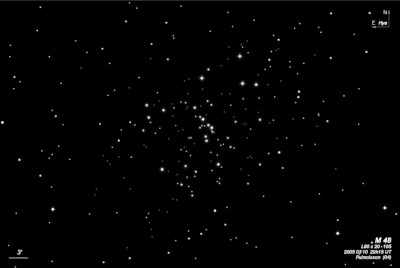
Charles Messier discovered M48 = NGC 2548 = H VI-22 = h496 on 19 Feb 1771 and described a "Cluster of very faint stars, without nebulosity; this cluster is a short distance from the three stars that form the beginning of the Unicorn's tail." Johann Bode independently found it the cluster again before 1782. But the identification of M48 was lost due to an error in Messier's listed position. In a 1934 book, Oswald Thomas identified M48 with NGC 2548 (without explanation) and in 1959 T.F. Morris pointed out that NGC 2548 has the same RA as Messier's position for M48 though differed by 5° in declination. Owen Gingerich publicized Morris' identification in his 1960 article "The Missing Messier Objects" in Sky & Tel.
Caroline Herschel independently discovered M48 on 8 Mar 1783 and William found it on 1 Feb 1786 (sweep 519). He recorded VI-22 (later NGC 2548) as "a beautiful cluster of stars, considerably rich, and pretty much compressed, 10 or 12' dia. The stars are nearly of a size, white and pretty large." He later noted "C.H. [Caroline Herschel] discovered it in 1783."
300/350mm - 13.1" (2/16/85): about 125 stars in a large 40' field with no distinct borders. A rich chain of stars oriented SSW-NNE passes through the center. Includes a number of brighter mag 10 stars and many double stars. Partially resolved in 16x80 finder.
400/500mm - 18" (3/15/10): large, sprawling cluster that nearly fills the 67' field of the 31mm Nagler. The most distinctive portion, though, is a 20'x15' group near the center which contains roughly 75 stars, many arranged in strings. Most prominent is a fairly dense SW-NE string of brighter stars that cuts through the cluster with a nice double star in the center (h 2435 = 9.6/9.7 at 7"). A short chain of a few stars branches off to the south of h2435. Another stream of stars branches off this string to the SSW. A third elongated group of stars extends SW-NE on the south side, roughly parallel to main string, and is separated by a mostly starless lane. The cluster includes a number of mag 8-9 stars, with the brightest mag 8.2. At 73x, the main cluster is wedged between two very long streams of stars, roughly oriented NW to SE off both the north and south sides of the main group. These two strings of stars extend the total diameter to over 50'. On the NW side of the central group, a number of stars are scattered between these two streams including a few very wide pairs, but the SE end the two streams are well separated with a very few stars in between.
Notes by Steve Gottlieb